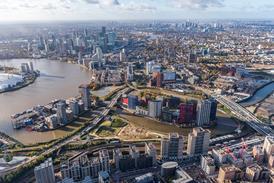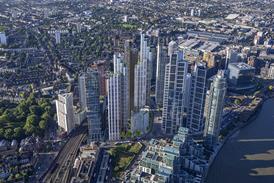By repurposing redundant offices into mixed-use buildings, we can create new vibrant urban communities, writes Daniel Leon

In June, HSBC announced that it would vacate its famous Canary Wharf headquarters for pared-down new premises in the City. What began as a trickle soon turned into a flood. HSBC has since been followed by Moody’s, Clifford Chance, and Credit Suisse – who have either sub-let sections of their office buildings, or have vacated them altogether.
This has little to do with – as some allege – any particular deficiency in Canary Wharf as a place to work. Rather, it speaks to changing patterns of work and life – changes that are beginning to make traditional models of commercial property obsolete.
The sudden rise of flexible working during the pandemic shows little sign of abating, and it has made firms of all sizes reconsider their office space arrangements. Overwhelmingly, the choice has been to radically downsize. We are now faced with the prospect of office towers, once the main fixtures of city centres, either shuttering or limping on half-empty.
Previously, the default solution for this kind of problem would have been to simply demolish these structures, and redevelop the sites into something else. But in 2023, this solution looks increasingly unjustifiable, given that two-thirds of the UK’s annual waste comes from the construction industry. The quandary remains.
Meanwhile, what the COVID-19 pandemic certainly did not make obsolete was high-quality housing in desirable locations like London, Cambridge, and Oxford. This is as scarce as ever, and demand for it has never been higher.
As a result, the challenge for the British built environment in the 2020s facing architects, developers, and planners is threefold. First, the decline of old models of commercial property will have to be adapted to. Second, the chronic shortage of housing must be addressed. Third, any solution to these problems cannot be solved through a frenzy of demolition and development, with all the attendant environmental costs that this would involve.
As office towers empty out, we should remodel these buildings to include residential, commercial, retail, scientific, and communal spaces
So far, the proposals for new ways to make use of city centres have not departed from orthodox assumptions about urban life. Ideas to, for example, turn the City of London into a hotel district, or to transform Canary Wharf into a centre for life sciences, still assume that a central urban area has to have a single basic purpose – before it was commercial offices, now it is to be something else.
I would propose that the best way to address the challenges facing British cities is to do the exact opposite. We should stop assuming that an individual building has to fulfil a single purpose, and should instead seek to refurbish these commercial offices into attractive mixed-use developments. As office towers empty out, we should remodel these buildings to include residential, commercial, retail, scientific, and communal spaces.
Mixed-use redevelopments could make a huge positive contribution to British cities. For one, it would help reduce the problem of urban sprawl. Clustering residential, commercial, and recreational facilities together would reduce the need for long commutes.
This would, in turn, lessen the need for an outward expansion of Britain’s cities into the green belt. With the decline of commercial offices, we have a golden opportunity to reverse the trend of outward urban expansion – with all its negative environmental effects.
Moreover, mixed-use redevelopment would do much to help reverse the problem of urban anomie and loneliness. Clustering working and living facilities together will serve to create small urban communities, centred around shared civic spaces.
The Barbican Centre – which was built to create a community of this kind – is rightly beloved by residents and visitors alike; now we have the chance to refurbish Britain’s cities in this spirit.
Mixed-use refurbishment represents the best way to solve the social, environmental, and economic problems facing British cities
In addition, mixed-use refurbishment would play an important role in easing the chronic housing shortage in desirable locales in the UK. Repurposing large sections of commercial office blocks as housing could create tens of thousands of downtown residential units.
The traditional proffered solutions to Britain’s housing crisis have been to either build up or build out – both of which have their disadvantages. The decline of commercial offices gives us a chance to cut this Gordian knot and inject our urban centres with a huge tranche of high-quality dwellings.
Refurbishing Britain’s city centres into a series of mixed-use complexes presents an exciting new challenge for architects, developers and planners. The zeitgeist seems to be aligned with this aspiration. With Housing Secretary Michael Gove’s recent decision to veto the levelling of M&S’s flagship store on Oxford Street, the worm may have turned: refurbishment, not demolition, seems to be the way forward for the British built environment.
To start to accomplish this, legislation must change. Gove’s plans to allow more retail units to be converted into homes is a step in this direction.But conversions like these will not make any real dent in the shortfall of housing, nor will they create the integrated mixed-use communities that could do so much to revitalise urban living. Broader changes in policy are needed – particularly when it comes to the planning system.
The process for converting office blocks is often an arduous one, requiring copious amounts of evidence to ‘justify’ a switch in use. These hurdles have, so far, bedevilled attempts in the City of London to put emptying towers to new use.
A far more drastic overhaul of the planning system will be needed if this new vision for cities is to be realised, up to and including even a partial privatisation of the planning system. In addition, the government must make it more financially viable to undertake such projects by – for example – reducing or eliminating the VAT charged on refurbishment projects.
Mixed-use refurbishment represents the best way to solve the social, environmental, and economic problems facing British cities in the 2020s. If architects, developers, and planners can rise to the challenge – and if the right legislation is forthcoming – then what we now have is a generational chance to change British urban living for the better.
>> Also read: ‘Communicating the value of architecture’: why Muyiwa Oki wants to shift the debate on reuse
Postscript
Daniel Leon is director of Square Feet Architects.
















No comments yet